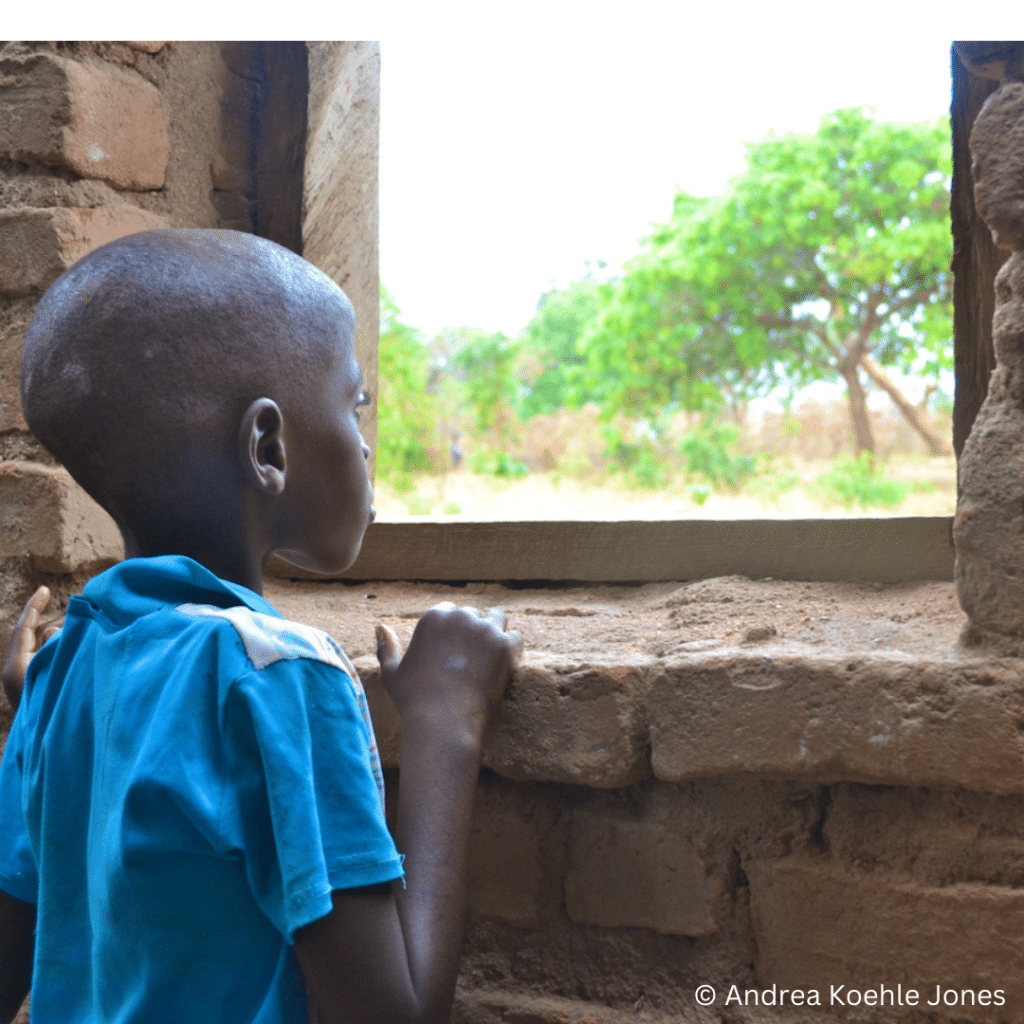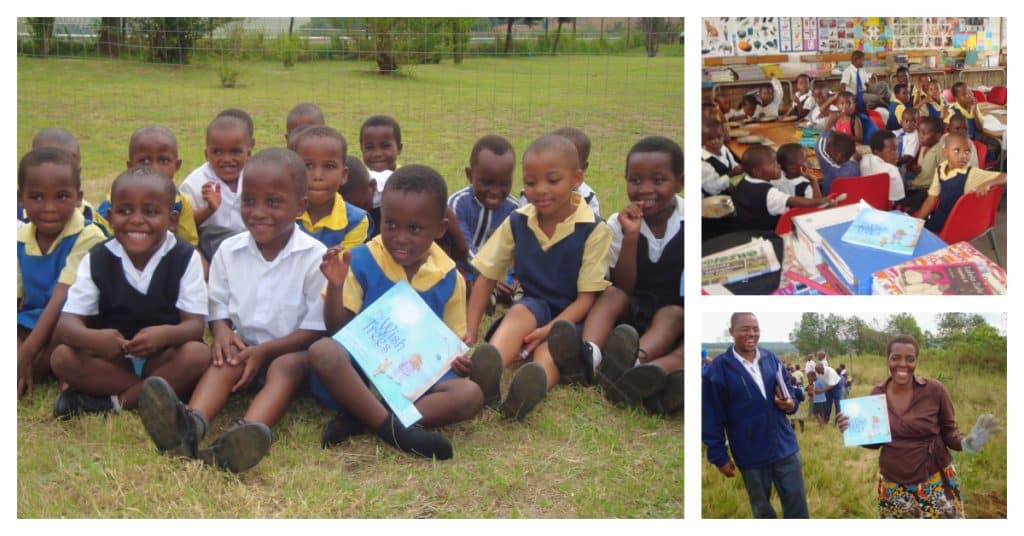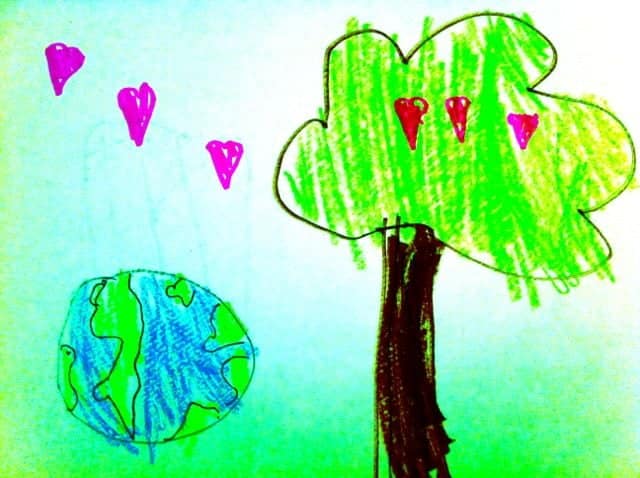Environmental education is the key to safeguarding children and youth from future impacts of climate change

Protecting children from the impacts of climate change requires urgent and decisive measures from the international community. This should be our top priority. So far, the world’s response to the climate crisis has been slow and disheartening. Millions of children and youth are already paying the price for this inaction and half the world’s children – over 1 billion – are at extreme risk from climate-related events. [i]
That’s why kids everywhere are calling on world leaders and the international community to show courage and take thoughtful and urgent action. Environmental education is a lasting solution that gives kids opportunities to survive and thrive while contributing positively to their ever-changing world.
Children require a clean, healthy, and sustainable environment as a fundamental right. Their future depends on it. Yet, the triple planetary crisis — the climate emergency, biodiversity loss, and pervasive pollution — poses an urgent and extensive threat to children’s health and well-being. By listening to children, we can understand their concerns and eagerness to help the planet.
The ChariTree Foundation is a small, grassroots environmental education and United Nations Climate Observer organization run for free by executive director and children’s environmental education advocate, Andrea Koehle Jones. The ChariTree Foundation strives to reach children and youth especially kids in areas hardest hit by the impacts of climate change and youth who would otherwise not be able to participate.
For nearly 20 years, The ChariTree Foundation has focused on providing experiential, hands-on environmental education to children in Canada and the Global South in an effort to address future impacts of climate change on kids. If you are looking for effective and relevant adaptation solutions, a strong place to start is to borrow some of the project ideas The ChariTree Foundation has successfully implemented and supported such as rural and urban tree planting projects, outdoor classrooms and beach cleanup parties.
“Children are the most impacted and least to blame for the climate crisis. We have a unique moment in history where we can champion environmental education for a global generation of kids growing up in a world accelerating towards runaway climate change and devastating biodiversity loss.”
— Andrea Koehle Jones, The ChariTree Foundation’s executive director and children’s climate education advocate.
Disproportionate impacts of climate change on children

When we understand current disproportionate impacts of climate change on children, we are better able to develop solutions to help kids adapt to future climate change impacts. These efforts can reduce vulnerability, build resilience, and minimize the negative consequences on children around the world.
Children are especially vulnerable to climate change impacts, due to their ongoing physiological growth and development, dependence on caregivers, limited mobility, and overall lack of decision-making authority.This is important because the impacts of climate change on children and youth are far-reaching and growing. These include physical health, mental health and social impacts:
PHYSICAL HEALTH IMPACTS
Heat-related Illnesses: Increasing temperatures and extreme heat events like heat domes can make children vulnerable to heat exhaustion, heatstroke, and dehydration, particularly in regions with extreme heat events.
Vector-borne Diseases: Climate change expands the geographic range of disease-carrying vectors like mosquitoes and ticks, boosting transmission of diseases such as malaria, dengue fever, and Lyme disease among children.

Water Scarcity and Waterborne Diseases: Children face increased risks of cholera and typhoid fever from inadequate and contaminated water sources caused by floods, droughts, as well as poor sanitation.
Food Security and Nutrition: Climate change fueled crop failures, logistics interruptions and soaring food prices lead to food shortages, higher prices and malnutrition. This in turn can have long-term effects on children’s physical and cognitive development.
Respiratory Issues: Declining air quality from wildfires, pollution, and allergens exacerbates children’s respiratory conditions like asthma and allergies.
Injuries: Sudden and extreme weather events like hurricanes, cyclones, floods, tornadoes, and wildfires can cause injuries and fatalities among children and their families. Children in communities with limited disaster planning, early warning systems, disaster relief and critical infrastructure are more at risk.
MENTAL HEALTH IMPACTS
Anxiety, Depression and Trauma: Climate Change can also contribute to disheartening psychological distress in children leading to anxiety, depression, and trauma, with lasting ramifications for their mental health and overall well-being. In 2021 researchers from the UK, Finland and the US published the first large-scale global survey of climate anxiety in children and young people aged 16 to 25. The survey found that 84 percent were at least moderately worried about climate change, and 59 percent were very or extremely worried. The emotions that they described ranged from sad and anxious, to angry and powerless. Around half of those surveyed highlighted that their daily lives and functioning were affected by climate anxiety. This study reinforced the conclusions of a survey published in 2020 by the UK Royal College of Psychiatrists, which revealed that over half (57 percent) of child and adolescent psychiatrists surveyed in England, were seeing children and young people distressed about the climate crisis and the state of the environment.[ii]

SOCIAL IMPACTS
Displacement and Migration: Catastrophic climate-related disasters like floods, storms, and rising sea levels can uproot families forcing them to migrate. Weather-related disasters have forcibly displaced an alarming 43.1 million children across 44 countries in the last six years, as reported by UNICEF. Of these recorded displacements between 2016 and 2021, floods and storms accounted for a staggering 40.9 million, or 95 percent. This increase can be attributed partially to improved reporting and proactive evacuation measures. Additionally, droughts led to over 1.3 million internal displacements of children[iii]. Displacement can amplify climate-related risks for children who lack resources and resilience to cope with its impacts resulting in disruptions to their opportunities, healthcare, and familiar social networks.
Education Disruptions: Forty million children are having their education disrupted every year because of disasters exacerbated by climate change, and this number continues to increase.[iv] Climate-related disasters often damage infrastructure and affect schooling, depriving children of their right to education and opportunities for learning and social development. This also impacts their ability to participate in environmental education programs that could help them thrive and survive in their ever-changing world.
Poverty Cycles: Climate change exacerbates existing poverty and inequality cycles by affecting children from marginalized communities that lack resources and resilience to cope with its impacts that includes access to empowering opportunities like environmental education. Without adequate Loss and Damage funding, we can’t break this cycle.
Relevant policy solutions
By teaching children and teens about climate adaptation strategies and resilience-building measures, they can actively participate in efforts to address the challenges posed by climate change. This includes learning practical skills such as tree planting, beach cleanups, disaster preparedness and water conservation. Environmental education solutions are especially powerful when we look for strategies to address future impacts of climate change on kids. Let’s work together to:
PROTECT the lives, health and well-being of children and youth around the world. This includes funding and providing access to environmental education to help kids cope with future climate impacts by becoming informed, proactive, compassionate and resilient when addressing the current and future challenges posed by climate change.

HONOUR, broaden and fund ambitious international climate change agreements with a focus on child rights and environmental education for everyone, especially children and youth. These agreements need to include kids in the decision-making process.
EDUCATE every child by supporting transformative, formal and informal climate education at all levels, including science-policy interface studies and lifelong learning processes, recognizing diverse world views, values and knowledge systems of indigenous peoples and local communities. When children understand climate change and how it impacts them and the world they depend on, they are more likely to make a lifelong commitment to protect the environment for themselves and future generations.
AWARENESS, EMPOWERMENT AND RESILIENCE BUILDING
Environmental education increases children’s awareness of climate change’s causes and impacts, empowering them to advocate for solutions and take action, such as tree planting or beach cleanups. Through education, children become active participants in addressing climate change by raising awareness and mobilizing support, promoting sustainable practices, and influencing their parents, family, teachers as well as decision-making processes. Additionally, environmental education builds resilience by teaching children adaptation strategies like water conservation and disaster preparedness, as seen in initiatives such as water conservation efforts and wildfire preparedness programs in British Columbia. When they understand people everywhere are working, often behind the scenes on adaptation and mitigation efforts, then kids can have hope.
MODELLING SUSTAINABLE PRACTICES
When parents, teachers, everyone leads by example and supports environmental education opportunities we grow empowered kids interested to adopting eco-friendly behaviors that combat climate change. Through critical thinking fostered by environmental education, children can identify climate change disparities and grow up to help develop innovative solutions, promoting equity, compassion and social justice. Engaging in environmental education from a young age fosters a long-term perspective on environmental stewardship, equipping children to grow-up to support and implement sustainable solutions that mitigate climate change impacts for future generations.
Climate action and nature protection starts with education.
Environmental education is a vital key to unlocking lasting solutions to safeguard children by helping to minimize the disproportionate impacts of climate change on children in the future. The solutions underway by The ChariTree Foundation are simple, free or low cost, and easily applied almost anywhere — and fun!
While the scale of climate change may seem daunting, The ChariTree Foundation honours individual actions that collectively have powerful results. Our grassroots approach aims to connect children to nature by supporting championing education and helping to build outdoor classrooms. This hands-on learning empowers kids to appreciate and protect nature, become ambassadors for climate action, builds their leadership skills, and gives them hope. It also reduces their stress while building critical thinking, creativity, resiliency, and social skills. Here’s what we have been doing.
Learning how to plant a tree
“Planting a tree is an act of hope for the future and children need to have hope now more than ever.”
— Andrea Koehle Jones, The ChariTree Foundation’s executive director and children’s climate education advocate.
ChariTree’s ‘A Tree for Every Child Program’ strives to give as many children as we can a tree of their own. It’s about supporting environmental education programs for children by giving kids a tree to plant at their home, camp or school that is native to their region ~ and an opportunity to connect with nature and contribute positively to their world.
When children plant trees they can learn:
- hands-on experience changing the world by learning how to plant and care for a tree
- STEM tree science and ecology
- forest connectivity and cooperation
- compassion for trees
- tree conservation
Over the past ten years, more than 120,000 children had the opportunity to plant a tree at summer camps across Canada and in Tanzania, Kenya, Ethiopia, Malawi and Nepal.

The ChariTree Foundation took tree requests from children’s camps, schools and community groups, sourced local seedlings, and shipped them so thousands of children could learn how to plant and care for them. Often these trees would help rewild land that had been impacted by wildfires, storms or insect infestations. Tree planting program ideas and instructions were provided online.
The ChariTree Foundation 2024 Camp Tree Planting & Biodiversity Education Grant was created to help help Canadian children’s camps purchase trees (for example, white spruce seedlings, douglas fir seedlings, apple trees…) for their campers to plant with camp staff as part of camp environmental education programs where camp staff plant trees with them. Every tree planted by kids leaves a lasting impact, knowing that they were part of something much bigger than themselves.
[v]“Getting the trees each year is a big thrill for our us. I think we have been involved for 5 + years with the program. It was a difficult year with the high heat in the early summer but we did our best to get trees in the ground and established early. It is rewarding to see trees from a few years ago doing well. We are always working to connect our campers with the natural environment.” — Jeff Brown, Owner/Director, Camp Otterdale, Lombardy, ON
“The children had a great day outside learning about the trees and how to plant and care for them. As the trees grow, they will provide important habitat and their shade will help maintain a healthy, cool water temperature in Joseph Creek. Thank you ChariTree!” ~ Blue Lake Camp, Cranbrook, BC
“There is something magical about the act of planting a tree. It is one of the best ways to foster hope and empowerment for a greener future. Kids love taking part in this meaningful act. Thank you for the opportunity.” — Jacob Rodenburg, an award-winning educator, author, executive director of Camp Kawartha, a summer camp and outdoor education center, and instructor in environmental education at Trent University, ON.

Building Outdoor Classrooms
Starting during the pandemic, The ChariTree Foundation has been expanding its climate education mandate by helping schools and children’s camps across Canada build outdoor classrooms.
The goal is to get kids outdoors more and give them more opportunities to participate in accessible outdoor learning, climate and biodiversity education programs.
“Outdoor classrooms offer students powerful environmental education opportunities and opportunities and build connections with each other and the natural world around them.”
— Andrea Koehle Jones, The ChariTree Foundation’s executive director and children’s climate education advocate.
Outdoor classrooms allow students (and teachers) to:
- develop a deeper appreciation for the natural world and foster a sense of stewardship for the environment. This connection with nature can lead to a greater understanding of ecological concepts and sustainability.
- boost health by promoting movement, exploration, and hands-on learning, contributing to better overall health for students. Plus nature has a calming effect reducing stress and anxiety levels.
- improve attention span, creativity and cognitive function.
- are simple and quick to build after climate disasters.
Inspiring Beach Cleanups
[vi]You’ll be amazed by the impact a group of enthusiastic kids can make in just a few hours. The ChariTree Foundation provides instructions to host beach cleanup parties and events.

Learn how to organize a beach cleanup. From EcoParent Magazine, How to Host a Kids’ Beach Clean-up Party: Helping the Planet & Having Fun Doing It! by Andrea Koehle Jones, Vancouver, March 2023.
Beach Clean-up Take Away for Kids
- encourages children to spend time outdoors to engage in physical activity and reduce stress.
- develops a connection and appreciation for their community and nature as well as compassion for aquatic life.
- provides a hands-on learning environmental education experience that complements their classroom education. Children learn about the impact of litter on marine life and coastal ecosystems through direct observation, interaction and teamwork.
- fosters a sense of hopefulness, empowerment and responsibility for the planet from a young age that inspires future climate leaders.
Other important solutions include:
- Encouraging publishers to prioritize fiction and non-fiction books with inclusive, environmental themes for children and young people. Ideally these books would be printed on 100% tree-free recycled paper and a program developed to distribute free book to children and families who can’t afford environmental education books. Also stocking public and community libraries with more environmental education books.
- Producing more fun, interactive media and gaming programs for kids with positive and hopeful environmental education themes.
- Encouraging parents and teachers to lead by example and talk with children and teens about climate change, biodiversity loss and solutions.
- Incorporating the youth perspective into environmental policy
- Advocating for environmental education opportunities for children and youth everywhere and preparing them to navigate their changing world.

___________________________________________________________________________________________________________________________________
SB60 Input on Expert Dialogue on Children and Climate Change from Andrea Koehle Jones, The ChariTree Foundation, May 7, 2024.
Greater Vancouver, British Columbia, Canada
Contact: info@charitree-foundation.org
The ChariTree Foundation is a United Nations Climate Observer Organization, putting children’s rights at the forefront of climate action to improve their education, health, and future.
Website:.charitree-foundation.org
Suggested citation. The climate crisis is a child’s rights crisis so who is looking out for kids?
Environmental education is the key to safeguarding children and youth from future impacts of climate change. Andrea Koehle Jones, Children’s Environmental Education Advocate, Founder, The ChariTree Foundation. (Greater Vancouver, May 2024)
COVER PHOTOGRAPH
Photo by Robert Kneschke / Canva Pro. Children running together at summer camp.
[i] Save the Children, How is the Climate Crisis Impacting Children? 2024 website, London, UK
[ii] EcoParent Magazine, Climate Anxiety and Kids: How to Help Manage Their Distress in These Uncertain Times, by Andrea Koehle Jones, Vancouver, November 2022.
[iii] United Nations Children’s Fund, The climate-changed child: A children’s climate risk index supplement, UNICEF, New York, November 2023.
[iv] United Nations Children’s Fund, Weather-related disasters displace 43.1 million children in six years, UNICEF reports, UNICEF UN News Global perspective Human stories, New York, October 2023.
[v] EcoParent Magazine, How to Host a Kid’s Tree-Planting Party: Get kids outdoors & care for our planet with more sustainable funby Andrea Koehle Jones, Vancouver, March 2024.
[vi] EcoParent Magazine, How to Host a Kids’ Beach Clean-up Party: Helping the Planet & Having Fun Doing It! by Andrea Koehle Jones, Vancouver, March 2023.
In May and June 2024, Andrea attended SBI-4, the fourth meeting of the Subsidiary Body on Implementation, at the United Nations Environment Headquarters in Nairobi. Then she participated in the Leading Minds conference at UNICEF Innocenti – the Global Office of Research and Foresight in Italy, a think tank collaborating on solutions to help children face the impacts of climate change head-on. “Climate Action: Breaking the barriers and challenging the status quo,” was co-created by young people, ensuring their voices were heard loud and clear.
Andrea also visited the Teule Kenya orphanage on the foothills of Mount Kilimanjaro. The ChariTree Foundation first started supporting environmental education for Teule Kenya children in 2011. Andrea was able to see some the amazing fruit trees and ‘The Children’s Forest’ planted by kids learning to plant trees.

Andrea says the time for action is now, and the power to effect change lies within each and every one of us.






